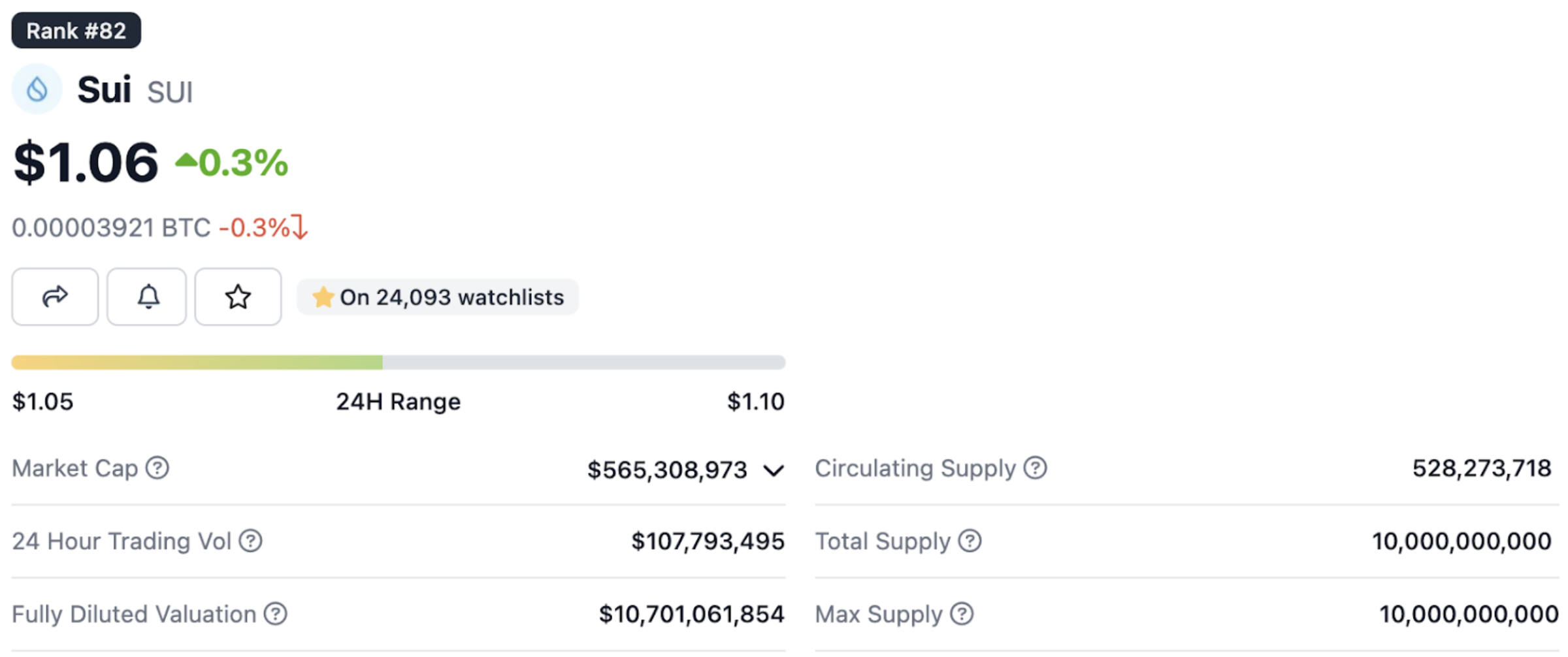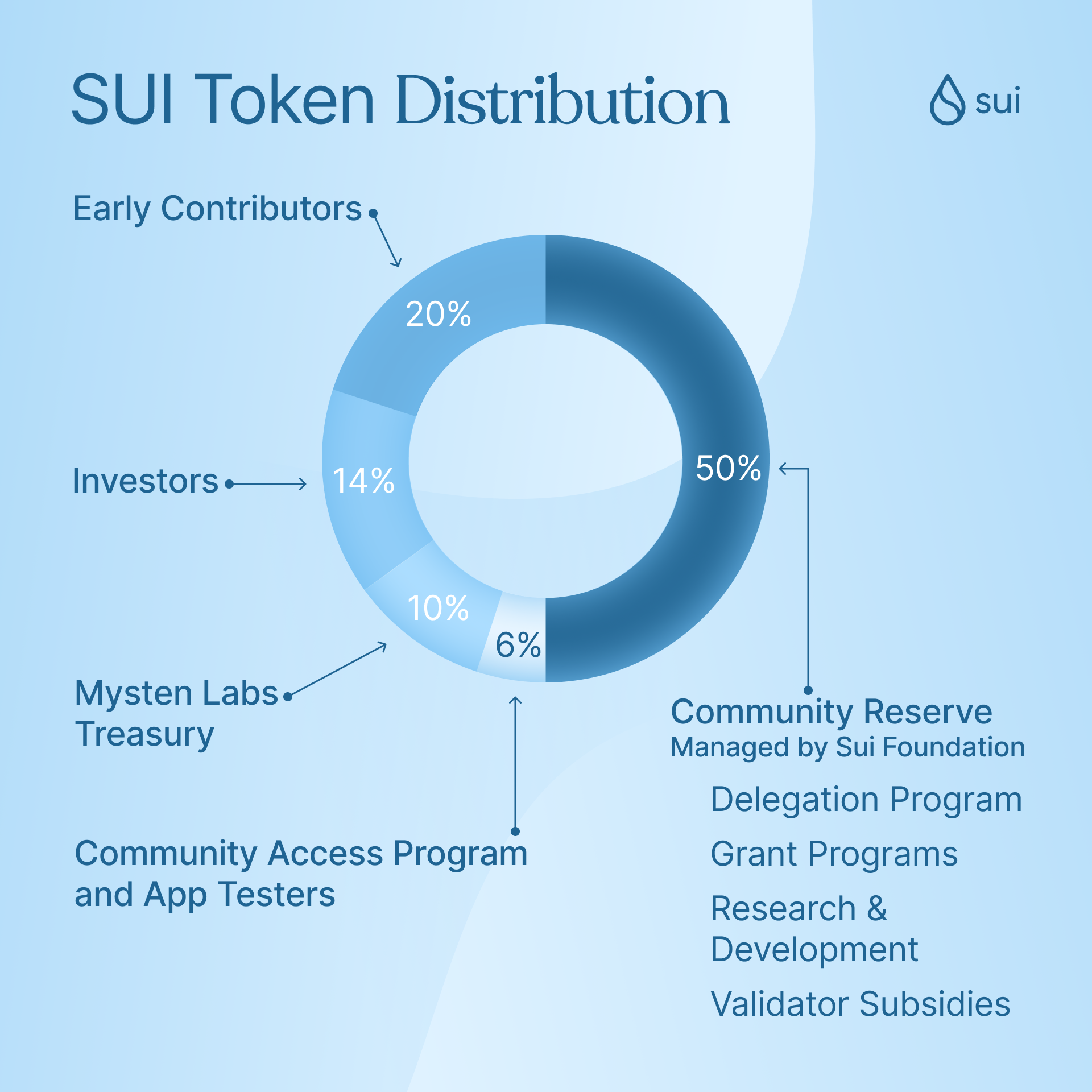When top Meta executives leave the company to create a fresh Layer-1 blockchain and smart contract platform, you know it's time to pay attention (and we're not talking about Aptos here). In Sep 2022, Sui made waves with a $300 million raise and a $2 billion valuation. As of May 2023, the blockchain reached $10 billion FDV.
Even with the ink barely dry on its incorporation documents, this blockchain has already collaborated with Alibaba, acquired equity in the beleaguered FTX, and grown an enviable ecosystem.
So, let's dive into Sui's ocean of potential, exploring its uses, unique features, and the hurdles that lie ahead.
What Is Sui Blockchain?
Sui, borrowing its name from the Japanese word for water, seeks to bring similar qualities of fluidity and flexibility to the Web3 ecosystem. It's a Layer-1 blockchain aiming to streamline development across a multitude of use cases.
The team at Mysten Labs, the architects of Sui, saw Web3's existing challenges with performance and complexity and wanted to create a solution. Their solution seems to be striking a chord as an array of gaming and DeFi projects are now establishing their foundations on it.
? Follow @hackenclub on Twitter
How Does Sui Blockchain Work?
Sui Move Language
Meta once embarked on a project to create a digital currency and blockchain called Diem. The team created Move as a smart contract language for Diem. Unfortunately, the project eventually failed, and Meta abandoned it.
But the Sui team adapted the language and formed the Sui Move Language. The syntax of core Sui and Sui Move are quite similar. Nonetheless, there are clear differences.
According to the documentation, Sui cannot utilize popular smart contract languages such as Solidity because of their inherent limitations. Only Sui Move can implement the core tenets of objects and parallel execution effectively.
In addition, Sui Move encourages data composability — this gives developers greater power and flexibility to manipulate data packages such as structs. This is an example of how a Sui Move immutable package object looks:
module hello_world::hello_world {
use std::string;
use sui::object::{Self, UID};
use sui::transfer;
use sui::tx_context::{Self, TxContext};
/// An object that contains an arbitrary string
struct HelloWorldObject has key, store {
id: UID,
/// A string contained in the object
text: string::String
}
public entry fun mint(ctx: &mut TxContext) {
let object = HelloWorldObject {
id: object::new(ctx),
text: string::utf8(b"Hello World!")
};
transfer::public_transfer(object, tx_context::sender(ctx));
}
}How to write “Hello World” in Sui Move. Source: Sui Move GitHub
Transactions
Sui recognizes two types of transactions: single-owner and shared objects. Single-owner transactions are performed by only one address, including minting and smart contract deployment. Shared object transactions, on the other hand, involve multiple addresses, such as an auction.
General Processing Of A Sui Transaction:
The user sends the transactions to a full node, which further broadcasts it to some validators and gathers the selected validators' signatures to issue a certificate. The certificate communicates with a wider array of validators that the transactions are totally verified.
Parallel Execution
Most other blockchains process transactions in ordered lists and this approach has been faulted for inefficiency. Therefore, it casually orders transactions rather than using a strict ordering scheme. The object-oriented nature of Move makes this possible because it executes in parallel.
It's noteworthy that Sui does not batch transactions into a block. Instead, it validates transactions individually and broadcasts a certificate to the network afterward.
Consensus
Sui adopts a proof-of-stake consensus mechanism for its staking program. SUI token holders can be rewarded for holding the token by delegating it to validators. In Sui, validators do not need consensus for transactions that involve exclusively owned objects. They only need it for transactions involving shared objects. The Sui consensus architecture has two major external components: Narwhal and Bullshark.
Mysten Labs discovered that the long delay in the mempool is a major reason behind slow transaction processing. Besides that, they believe the mempool should be a distinct component from the consensus protocol to a point where the consensus protocol can only order transactional metadata alone. Hence, the reason for Narwhal — a fast-processing memory pool to catalyze transaction processing.
The main work of Narwhal as a mempool is to ensure the cryptographic availability of the data to be submitted to Bullshark. Once transactions are out of the mempool, they go into the Bullshark consensus engine.
Bullshark is in charge of ordering the data supplied by Narwhal. It uses a Byzantine Fault Tolerance mechanism to check the validity of transactions and broadcast them accordingly.
Use Cases Of Sui Blockchain
The Sui mainnet was launched on May 3, 2023. Even before that, there have been noticeable use cases for the blockchain:
Gaming Experience
Gaming is one of the greatest routes through which more people get into Web3. The object-based blockchain is an attractive fit for game developers hoping to use a large number of in-game assets.
As of May 2023, about 9 gaming projects are on Sui. Abyss World is one such game, a high-fantasy and action game where the players embark on adventures. Run Legends, another dApp on Sui, helps users become fitter. Their movements count as attacks in the game.
Other games include Cosmocadia and Panzerdogs. Recently, Orange Comet, a popular Web3 gaming and entertainment company, partnered with Sui to launch immersive games on it.
DeFi Protocols
The Sui Move also has in-built security features, helping developers build more secure financial packages. This includes Turbos Finance, OmniBTC, Cetus, Aftermath Finance, Cetus Protocol, and lots more.
However, note that Sui can only process around 4 transactions per second for now. Thus, the blockchain must catch up regarding payment and asset transfer throughput.
Decentralized Social Interaction
There are various community-centric dApps. Polymedia Chat, for example, is a social network where people can chat on-chain without the fear of centralized censorship.
Suia is another dApp on Sui. It matches people with some similar classes of NFTs into an on-chain family, thereby fostering social interaction. The project currently boasts over 300k communities and over 220k users.
NFT Projects
Sui currently hosts 7 NFT projects: Cosmocadia, Haven’s Compass, Abyss World, Studio Mirai, Aftermath Finance, Run Legends, and Suia. Studio Mirai, for example, focuses on fashion and lifestyle. So far, the project claims to have facilitated several streetwear, fashion events, and so on. For now, there are a few NFT projects, but their number and quality will likely increase over time.
Key Features Of Sui Blockchain
Gasless Transactions
New users coming to Web3 often need to be made aware of the numerous processes of paying gas fees. Sui encourages the dApp to settle gas fees beforehand, while the users simply go ahead to cavities without bothering about gas.
Package Upgrades
Upgradeability is important for developers to add or remove functionalities from smart contracts even after deployment. Smart contracts in Sui exist as immutable package objects. Sui supports a more seamless pattern of upgrading packages so developers can display more control over their contracts.
ZK Implementation
Zero-knowledge proofs are becoming more important in Web3 for privacy and anonymity. Sui protects user privacy with ZK-embedded architecture and OpenID for logins.
League of Entropy
Projects such as betting and gaming often require tamper-proof random numbers. However, some blockchains have flawed and insecure languages for generating randomness. Sui was built to support a more efficient randomness generation scheme called Drand of Beacon under the League of Entropy.
Dynamic and Composable Object
Almost every data or stored value in Sui appears as an object. These objects have programmable and inherent properties. Every object is directly stored on-chain.
Single-owner objects are simply broadcast throughout the network. But shared objects go a step further to require undergoing a consensus.
Note that an object can own another object, thus opening possibilities for composability. Dynamism is one of the key features of Sui.
Sui Tokenomics
SUI Token

The blockchain’s native asset is the SUI token, serving as an incentive mechanism for all the parties in a decentralized network. The SUI token has 4 primary utilities:
- Staking
- Paying gas fees
- Providing on-chain liquidity
- Governance
As of May 2023, there’ve been around 530 million SUI in circulation, while the max supply is limited to 10 billion tokens. The most recent SUI token distribution was disclosed in December 2022.

Staking
The following diagram illustrates the staking rewards distribution flow for SUI.

Gas-Pricing Mechanism
Sui users pay for transaction processing, deployment, and storage. Consequently, the gas fees for each object are determined by combining the costs of computation and storage using the following formula:
F = (CU x CP) + (SU x SP)
F: Gas Fees
CU: Computational Unit
CP: Computational Price
SU: Storage Unit
SP: Storage Price
Storage Fund
Records and metadata of objects—or in this case, transactions—are stored on Sui. Since these records occupy space, users have to pay for them, and these payments will be kept in the storage fund.
Validators receive these payments as compensation for data storage costs. From a business standpoint, this model was developed to reward validators for their work.
Note also that objects can be deleted from the storage fund. If a user does this, they get some part of the storage fees they paid initially.
Aptos Vs. Sui
There are a lot of similarities between Aptos and Sui. Indeed, they are closer to L1 ecosystems as they have similar programming languages; Move for Aptos and Sui Move for Sui. Besides that, their founding teams have a common experience working at Meta.
While they may look similar, they have a few points of difference.
First, Aptos uses a more native Aptos Byzantine Fault Tolerance algorithm, while Sui uses only proof-of-stake. Secondly, their programming languages are different. Even though Sui Move was adapted from core Move, they are different. Similarly, Sui places more emphasis on objects than Aptos, with clearer indications of different asset states (owned, shared, mutable, etc).
| Sui | Aptos | |
| Layer | Layer 1 | Layer 1 |
| Language | Sui Move - More object-centric storage system | Core Move |
| Founders | Meta background | Meta background |
| Consensus | PoS - dPOS | PoS - AptosBFT |
| Mainnet | May 3, 2023 | October 17, 2022 |
Challenges And Limitations Of Sui Blockchain
Even though Sui is thriving, some bottlenecks must be fixed for its adoption.
- Low Developer Adoption of Sui Move.
One of the primary reasons Ethereum thrives is due to many developers that can write Solidity and Vyper. The same applies to Solana and Polkadot because many developers are familiar with Rust.
Move is a relatively new language, and Sui Move is way newer. This presents an issue as only a handful of developers can write robust Sui Move immutable package objects — or smart contracts for short.
To break the language barrier, there must be a rapid and widespread onboarding of more developers into the Sui ecosystem.
- General User Adoption
Like Sui's issue with onboarding more developers, it has a long way to go in convincing builders and degens to use its chain.
There are currently competitive L1 blockchains that the users are familiar with. Besides, Sui is a new blockchain, and projects must ensure its security and popular adoption.
- Slow TPS
Even though Sui claims low latency and faster throughput, it has yet to achieve it. As of May 17th, 2023, the TPS of Sui was 3. This is extremely low compared to other blockchains that are running thousands of transactions per second.
Conclusion
From a technical standpoint, Sui is an L1 with thoroughly outlined architecture, tokenomics, and well-researched engineering underpinning.
However, the blockchain still has a long way to go in realizing its vision. It has major problems concerning adoption and transactional speed, which will probably be solved over time.
Zooming out, Sui can potentially repaint the outlook of Web3 gaming—and some of its other use cases—in the future.



